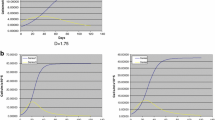Abstract
A system is described consisting of a chemostat for culturing algae, a dilution unit and special experimental vessels, allowing long-term experiments with filter feeders at a constant concentration and quality of food. The algal suspension flows continuously from a chemostat, is mixed with sterile filtered water, and pumped directly into the experimental vessels. The flow through the vessels is intensive enough to avoid a significant change in food concentration by sedimentation or grazing. There are two possible arrangements, the first providing many duplicates with exactly the same food concentrations, the second providing a series of graduated food concentrations. Details of construction are given. The application of both arrangements is demonstrated by experiments with Daphnia pulex. Further possibilities of application are suggested.
Similar content being viewed by others
Literature Cited
Ali, R. M.: The influence of suspension density and temperature on the filtration rate of Hiatella arctica Mar. Biol. 6, 291–302 (1970)
Arnold, D.E.: Ingestion, assimilation, survival, and reproduction by Daphnia pulex fed seven species of blue-green algae. Limnol. Oceanogr. 16, 906–920 (1971)
Chu, S.P.: The influence of mineral composition of the medium on the growth of planktonic algae. I. Methods and cultural media. J. Ecol. 30, 284–325 (1942)
Müller, H.: Wachstum und Phosphatbedarf von Nitzschia actinastroides (Lemm.) v. Goor in statischer und homokontinuierlicher Kultur unter Phosphatlimitierung. Arch. Hydrobiol. (Suppl.) 38, 399–484 (1972)
Müller, H. Die Bildung von Geruchsstoffen durch Asterionella formosa Hass. unter verschiedenen Wachstumsbedingungen. I. Eine Anlage zur serienweisen Chemostat-Kultur von Planktonalgen. Arch. Hydrobiol. 48, (Suppl.) (In press). (1976)
Paffenhöfer, G.-A.: Cultivation of Calanus helgolandicus under controlled conditions. Helgoländer wiss. Meeresunters. 20, 346–359 (1970)
Reeve, M.R.: Growth efficiency in Artemia under laboratory conditions. Biol. Bull. mar. biol. Lab., Woods Hole 125, 133–145 (1963)
Richman, S.: The transformation of energy by Daphnia pulex. Ecol. Monogr. 28, 273–291 (1958)
Schmidt, G.W.: Zur Ausnützung des Nahrungsstick-stoffs durch Daphnia magna Strauss. Arch. Hydrobiol. 65, 142–186 (1968)
Taub, F.B. and A.M. Dollar: A Chlorella-Daphnia food chain study: the design of a compatible chemically defined culture medium. Limnol. Oceanogr. 9, 61–74 (1964)
Winter, J.E.: The filtration of Mytilus edulis and its dependence on algal concentration, measured by a continuous automatic recording apparatus. Mar. Biol. 22, 317–328 (1973)
Author information
Authors and Affiliations
Additional information
Communicated by O. Kinne, Hamburg
Rights and permissions
About this article
Cite this article
Lampert, W. A directly coupled, artificial two-step food chain for long-term experiments with filter-feeders at constant food concentrations. Marine Biology 37, 349–355 (1976). https://doi.org/10.1007/BF00387490
Accepted:
Issue Date:
DOI: https://doi.org/10.1007/BF00387490




